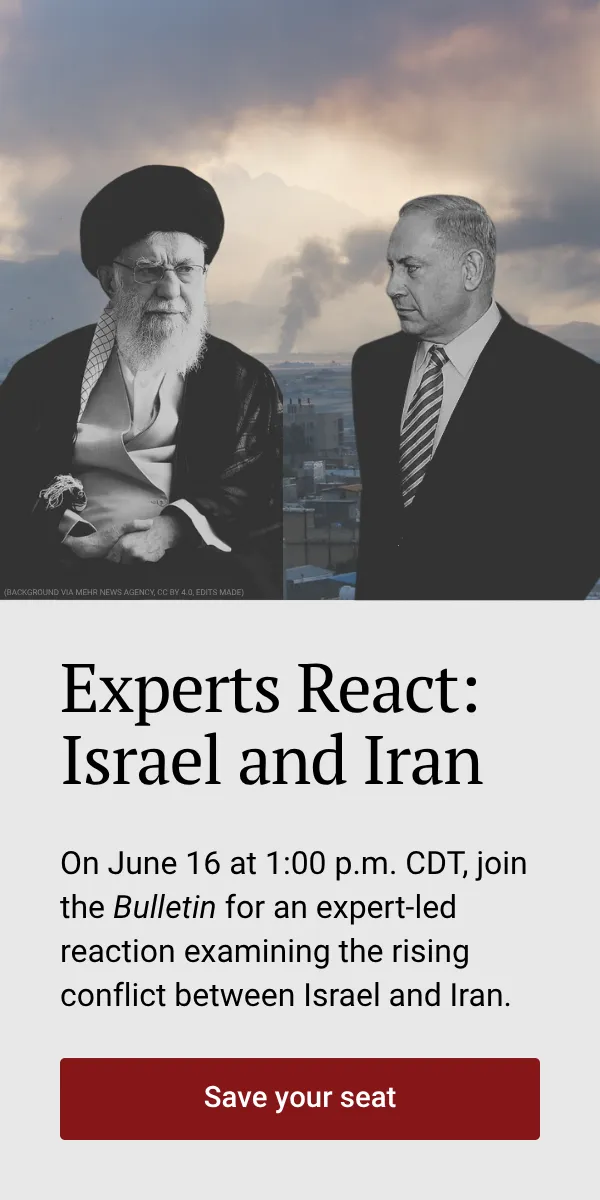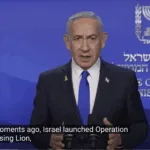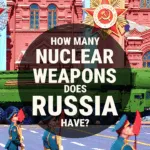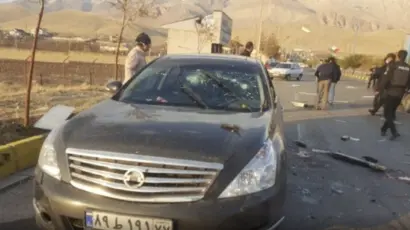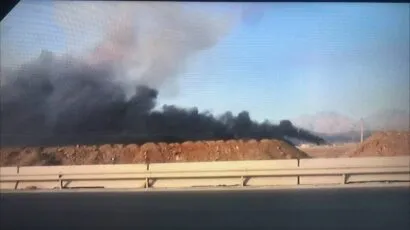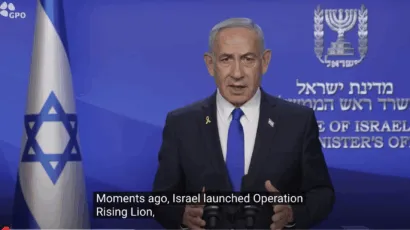Israel claims it damaged Iran’s Natanz nuclear facility “significantly.” But questions remain
By François Diaz-Maurin | June 13, 2025
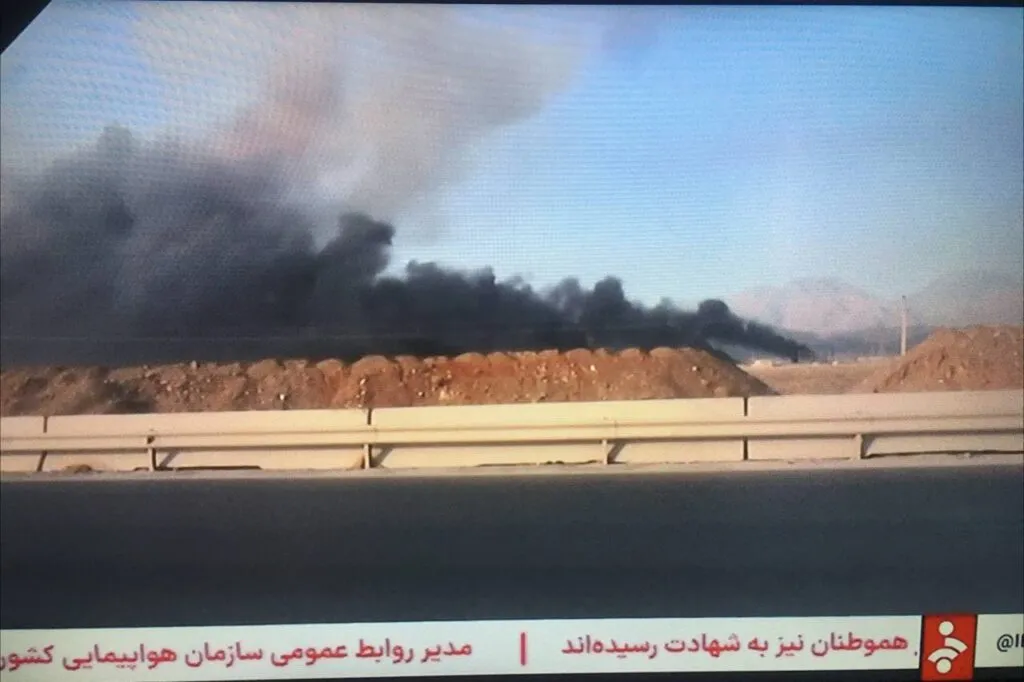 Iranian state-run media reported seeing explosions outside of the Natanz nuclear facility in central Iran, confirming the facility had been targeted by Israel's strikes on early Friday. (source: Telegram)
Iranian state-run media reported seeing explosions outside of the Natanz nuclear facility in central Iran, confirming the facility had been targeted by Israel's strikes on early Friday. (source: Telegram)
Editor’s note: This is a developing story that will be updated.
Early Friday, Israel conducted air strikes on the Natanz nuclear facility, Iran’s main enrichment site. The strikes were part of a larger operation by the Israeli military that targeted nuclear sites, long-range missile facilities, military leaders, and nuclear scientists across Iran.
It was not clear how much damage the Natanz nuclear site—which hosts both a commercial fuel enrichment plant for use in things such as powering civilian nuclear reactors, and the more technologically advanced and opaque so-called pilot fuel enrichment plant (PFEP)—had sustained from the strike. Israel’s military published its own assessment of the attack, claiming that they have damaged the underground area of the site. This area reportedly contains a multi-story enrichment hall with centrifuges, electrical rooms, and additional supporting infrastructure, which can be used to enrich uranium to military-grade levels. During a briefing, Israel Defense Forces (IDF) spokesperson Efi Defrin said the Natanz nuclear site was “significantly damaged.”
“It’s difficult to assess the consequences of the strikes on the nuclear program itself and the facilities, as we are still waiting for independent analyses of the satellite imagery,” Héloïse Fayet, a research fellow at the French Institute of International Relations and an expert of nuclear proliferation in the Middle East, told the Bulletin.
Unverified footage shared on social media from near the Natanz facility seemed to show repeated explosions at four locations. This seems to be consistent with the description of the facility, believed to consist of three underground buildings and six above-ground buildings.
As the operation was reportedly still ongoing, many questions about the attack remain unanswered. Here are some of the unknowns about the attack.
When will the attack be over? During a live briefing on Friday morning, Defrin said that “more than 100 targets have been struck across Iran.” And in his address, Netanyahu said that the operation “will continue for as many days as it takes to remove that threat.”
Defrin added that pilots were “still striking military targets and targets from the nuclear program across different areas in Iran,” which the Israeli military said involved about 200 fighter jets.
It is not clear how long the attack will last.
What are the other nuclear facilities targeted? On early Friday, the IAEA confirmed with Iranian authorities that the Fordow fuel enrichment plant, located near Qom in central Iran, had not been targeted during Israel’s attack. But new reports later suggested that Israel was actively attacking the plant, with residents reportedly having heard large explosions coming from the plant’s underground complex and smoke seen rising from several locations in the vicinity of the site.
The IAEA also said the Isfahan nuclear complex had not been targeted, contradicting reports of explosions near the site. The Isfahan Nuclear Technology Center, located 340 kilometers south of Tehran, hosts nuclear research reactors, a uranium conversion plant, and a fuel production plant, among other facilities. On Friday evening, the IDF confirmed that it also targeted the Isfahan complex, but offered no evidence.
Was the United States involved in the attack? According to The Washington Post, Trump officials have said that there was no US military support in the attack. But it is still unknown whether the United States provided indirect intelligence or logistical support for the attack.
Some news reports claim Israeli officials as saying that the United States may be opposing the attack only publicly, adding that the Trump administration did not express opposition in private. “We had a clear US green light,” one official reportedly told Axios.
Was the attack necessary? Israel’s military called its operation “preemptive” due to the imminent nuclear threat from Iran. During his address moments after launching the attack, Israel Prime Minister Benjamin Netanyahu said the operation was necessary because “Iran has produced enough highly enriched uranium for nine atom bombs,” adding that “Iran could produce a nuclear weapon in a very short time.” For its part, Israel’s military said “[Iran’s] program has accelerated significantly in recent months, bringing the regime significantly closer to obtaining a nuclear weapon.”
Reports that Israel was preparing to conduct such attacks have been made for over a year, and right-wing columnists have, for years, openly called on Israel to do so.
But several agencies and analysts dispute the claim that the threat of an Iranian nuclear bomb was imminent. A May 22 report to the House Foreign Affairs Committee concluded that “the US intelligence community continues to assess that Iran is not currently undertaking nuclear weapons-related activities,” although adding that “Iran could enrich enough uranium for more than a dozen nuclear weapons within weeks if it chose to do so.”
On May 31, a classified report of the International Atomic Energy Agency that was leaked to the press found that Iran had dramatically increased its production of near-grade (60 percent) enriched uranium since February, and that Iran continued to refuse to provide the IAEA with details of its enrichment sites, material, and activities. The report came amid negotiations between the United States and Iran over a possible new nuclear deal that they started to negotiate in April.
Netanyahu himself said that “it could be a year; it could be within a few months—less than a year” before Iran could build a nuclear weapon. This would have been enough time for nuclear negotiations to take place.
How is the attack going to affect nuclear negotiations? Israel’s decision to attack Iran despite US officials calling for restraint strikes a blow to the Trump administration leadership.
There is no doubt that Iran may not be willing to enter negotiations after the attack. Iran says it considers Israel and the United States responsible for the attacks, and has vowed a “harsh response.”
A third round of US-Iran talks was scheduled to occur in Oman on Sunday. Oman, which mediates the talks, condemned Israel’s attack as “reckless” and conducted at an “extremely sensitive time” for the nuclear negotiations.
Did the attack successfully roll back Iran’s nuclear program? Despite several Iranian nuclear facilities reported as being targeted by heavy military strikes, it is difficult at this stage to assess how successful Israel’s operation has been, especially as it was still ongoing as of Friday evening.
But Jon Wolfsthal, a nuclear expert and director of global risk at the Federation of American Scientists, is skeptical that the attack may have significantly altered Iran’s nuclear program. “Iran has likely been planning for this day for months or years. We have to assume they have stored a lot of capabilities to rebuild and even to build a weapon in short order.”
According to Wolfsthal, Israel’s attack may be counterproductive.
“You cannot bomb away a nuclear program.”
Together, we make the world safer.
The Bulletin elevates expert voices above the noise. But as an independent nonprofit organization, our operations depend on the support of readers like you. Help us continue to deliver quality journalism that holds leaders accountable. Your support of our work at any level is important. In return, we promise our coverage will be understandable, influential, vigilant, solution-oriented, and fair-minded. Together we can make a difference.
Keywords: Iran, Iran nuclear program, Israel, Natanz enrichment plant, Netanyahu, nuclear proliferation, nuclear weapons
Topics: Nuclear Risk, Nuclear Weapons

